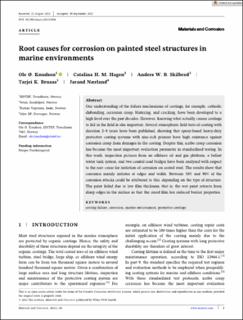| dc.contributor.author | Knudsen, Ole Øystein | |
| dc.contributor.author | Hagen, Catalina Hoem Musinoi | |
| dc.contributor.author | Skilbred, Anders Werner Bredvei | |
| dc.contributor.author | Bruaas, Tarjei K. | |
| dc.contributor.author | Nærland, Jarand | |
| dc.date.accessioned | 2024-04-11T08:06:53Z | |
| dc.date.available | 2024-04-11T08:06:53Z | |
| dc.date.created | 2023-11-06T15:39:50Z | |
| dc.date.issued | 2023 | |
| dc.identifier.citation | Materials and corrosion - Werkstoffe und Korrosion. 2023, Early view. | en_US |
| dc.identifier.issn | 0947-5117 | |
| dc.identifier.uri | https://hdl.handle.net/11250/3125983 | |
| dc.description.abstract | Our understanding of the failure mechanisms of coatings, for example, cathodic disbonding, corrosion creep, blistering, and cracking, have been developed to a high level over the past decades. However, knowing what actually causes coatings to fail in the field is also important. Several atmospheric field tests of coating with duration 2–9 years have been published, showing that epoxy-based heavy-duty protective coating systems with zinc-rich primers have high resistance against corrosion creep from damages in the coating. Despite this, scribe creep corrosion has become the most important evaluation parameter in standardized testing. In this work, inspection pictures from an offshore oil and gas platform, a ballast water tank system, and two coastal road bridges have been analyzed with respect to the root cause for initiation of corrosion on coated steel. The results show that corrosion mainly initiates at edges and welds. Between 50% and 90% of the corrosion attacks could be attributed to this, depending on the type of structure. The paint failed due to low film thickness, that is, the wet paint retracts from sharp edges in the surface so that the cured film has reduced barrier properties. | en_US |
| dc.language.iso | eng | en_US |
| dc.publisher | Wiley | en_US |
| dc.rights | Navngivelse 4.0 Internasjonal | * |
| dc.rights.uri | http://creativecommons.org/licenses/by/4.0/deed.no | * |
| dc.title | Root causes for corrosion on painted steel structures in marine environments | en_US |
| dc.title.alternative | Root causes for corrosion on painted steel structures in marine environments | en_US |
| dc.type | Peer reviewed | en_US |
| dc.type | Journal article | en_US |
| dc.description.version | publishedVersion | en_US |
| dc.rights.holder | © 2023 The Authors. Published by Wiley. | en_US |
| dc.source.pagenumber | 10 | en_US |
| dc.source.journal | Materials and corrosion - Werkstoffe und Korrosion | en_US |
| dc.identifier.doi | 10.1002/maco.202314046 | |
| dc.identifier.cristin | 2192819 | |
| dc.relation.project | Norges forskningsråd: 321056 | en_US |
| dc.relation.project | Norges forskningsråd: 311714 | en_US |
| cristin.ispublished | true | |
| cristin.fulltext | original | |
| cristin.qualitycode | 1 | |

